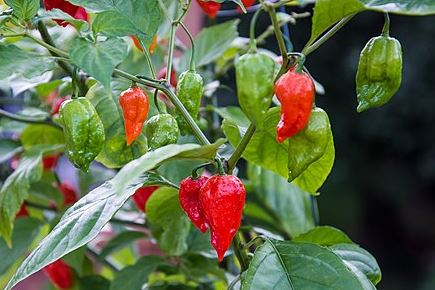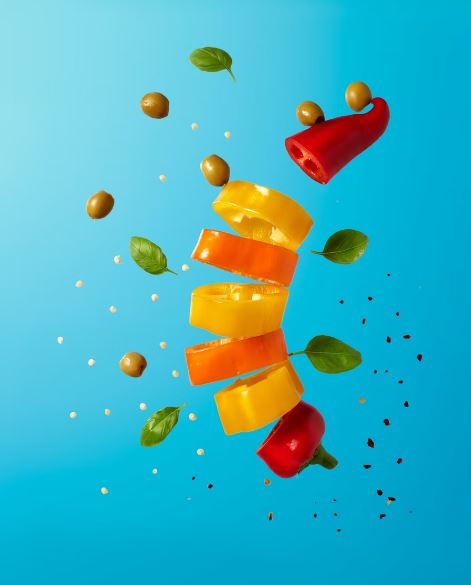The Ghost Pepper is an interspecific hybrid chili pepper grown in Northeast India. It is also known as Bhut Jolokia, which literally translates to “Bhut pepper” in Assamese. It is a cross between Capsicum frutescens and Capsicum chinense. If there are different types of salt, of course, peppers have different kinds also. One of these is the Ghost Pepper. The ghost pepper, which is 170 times hotter than Tabasco sauce, was officially recognized as the world’s hottest chili pepper in 2007 by Guinness World Records. More than one million Scoville Heat Units are assigned to the ghost chili (SHUs). The Trinidad Scorpion Butch T pepper and Carolina Reaper surpassed the ghost chili in the contest to produce the spiciest pepper in 2011 and 2013, respectively.
The Etymology and Regional Names of Ghost Pepper
The first element of the name, bhüt, which means Bhutan in Assamese, was mistakenly confused with a close homonym, bhut, which means ghost. The name Bhüt Jolokia means Bhutanese pepper. The Assamese words bih, which means poison, and zôlôkia, which means chili pepper and refers to the heat of the plant, are combined to form the name “poison chili” for the pepper in Assam. The pepper is known as Naga morich in Bangladesh (Naga chili). Similar names for the chili include Naga jolokia and bhut jolokia in Nagaland, one of the growing regions. This name is particularly prevalent in other growing areas, like Assam and Manipur. Saga jolokia, Indian mystery chili, and Indian rough chili are also used on the subcontinent. In honor of the Assamese city of Tezpur, it has also been referred to as the Tezpur chili. The word for chili in Manipur is umorok or oo-morok (tree chili). The bhut jolokia is also referred to as the king chili or king cobra chili in northeastern India.
Scoville Heat Rating of Ghost Pepper
The ghost pepper had a Scoville rating of 855,000 SHUs in 2000, according to India’s Defense Research Laboratory (DRL), and 1,041,427 SHUs in 2004 based on HPLC analysis. For comparison, pure capsaicin, the chemical that gives pepper plants their pungency, rates at 16,000,000 SHUs while Tabasco red pepper sauce has a SHU rating of between 2,500 and 5,000.
Ghost peppers grown from seed in southern New Mexico had a Scoville rating of 1,001,304 SHUs by HPLC in 2005, according to the Chile Pepper Institute at New Mexico State University in Las Cruces, New Mexico. Unlike most peppers, ghost peppers produce capsaicin in vesicles that are present throughout the fruit as well as the placenta around the seeds.
Characteristics of Ghost Pepper
Red, yellow, orange, or chocolate-colored ripe peppers are 60 to 85 mm (2.4 to 3.3 in) long and 25 to 30 mm (1.0 to 1.2 in) wide. The ghost pepper plant from India’s unselected strain is incredibly variable, with a wide range in fruit sizes and fruit production per plant. Ghost pepper pods stand out from other peppers due to their distinctive shape and delicate skin. The smooth fruit and the rough, dented fruit are the two distinct varieties of the red fruit variety. While the smooth fruit plants are more compact and have stronger branches, the rough fruit plants are taller and produce more fruit. At 32–38 °C, it takes roughly 7–12 days for it to germinate.
Uses of Ghost Pepper
Both food and spices are made from ghost peppers. It is used to “heat up” curries, pickles, and chutneys in both fresh and dried forms. It is frequently combined with pork, dried, fermented fish, or both. The peppers are used in smoke bombs or applied to fences in northeastern India as a safety measure to deter wild elephants. Due to its extreme heat, the pepper is a standard in competitive chili-pepper eating.
How Hot Are Ghost Peppers?
Let’s compare the ghost pepper to our jalapeño frame of reference. Although many individuals believe the jalapeño to be quite hot, according to the Scoville scale, it is actually a mild to medium chili pepper (2,500 to 8,000 Scoville heat units or SHU). Now increase the heat of the jalapenos by up to 400. The potential of ghost pepper is that (855,000 to 1,041,427 SHU.)
Like the scotch bonnet or habanero’s scorching heat (both 100,000 to 350,000 SHU). Compared to those hot chilies, it is four to eight times spicier. In order to prevent wild elephants from entering certain areas, locals smear the ghost pepper on fences and walls. The ghost pepper is so hot that the Indian army has turned it into military-grade smoke bombs. Never use bare hands to touch any of the super hots. When handling seeds or hot peppers, wear gloves made of latex or nitrile. I’ve discovered that the pepper oil still penetrates even the simplest plastic food prep gloves.
What Do Ghost Peppers Look Like?
The fruits are two to three inches long and resemble pods. Like most hot peppers, the typical Bhut Jolokia matures from green to red. Although not as pronounced as the Trinidad Moruga Scorpion’s tail, the pods themselves taper to a point. Additionally, the skin develops a wrinkled, pock-marked texture similar to other super-hots. Like all super-hots, she exudes a certain level of danger, as if this is not something to be taken lightly.
What Do Ghost Peppers Taste Like?
Believe it or not, there is flavor beyond the intense spiciness. Since the heat in this chili builds gradually, you get to enjoy the flavor for at least a few seconds before it hits you. They have the typical sweet, fruity flavor of many extremely hot peppers, but they also have a faint smokiness to them. Of course, once the heat intensifies and persists, everything disappears. The main impression that remains afterward will be intensely painful spice that may last for at least 15 minutes.
Are Ghost Peppers Healthy?
Similar to all hot peppers, they are quite nutrient-dense. There’s a big catch, though. You consume fewer ghost peppers in a sitting than other chilies due to their intense heat. This means that compared to a pepper like the highly palatable jalapeño, you only receive a small portion of the advantages.
Other Good Uses of Ghost Pepper
Although the Bhut Jolokia is one of the hottest peppers in the world, you can still create some incredible culinary dishes using ghost peppers. You can even add it to your organic mushroom snacks. Bhut Jolokia is the primary hot pepper ingredient in some of the spiciest and most delicious hot sauces on the market. Additionally, it is used to make Indian, Mexican, and Tex-Mex dishes extremely spicy. Even well-known fast food chains have fallen for the marketing gimmick. For instance, Red Robin added two burgers with ghost pepper sauces to its menu. But even though those sauces lack the Bhut Jolokia’s potent heat, they are still delicious.
The intense heat makes this chili very popular during the summer because sweating causes the body to cool down. If you’re feeling creative, you can use these peppers raw or dried to make salsas, sauces, and other dishes.


